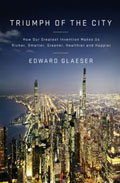-
(单词翻译:双击或拖选)
Big cities are vibrant1 hubs for culture and industry, or dirty, congested, impersonal2 crime-ridden warrens. As the world population surpasses seven billion, economists4, environmentalists and social scientists are rethinking the role of the city in global society.
Economist3 Edward Glaeser believes cities are the best places to live. “Cities are so fascinating because they play to mankind’s greatest gift, which is our ability to learn from other people.”
Since ancient times, he says, cities have attracted smart people and enabled them to work collaboratively to advance society. But it wasn’t always a smooth road.
“In the 1970s, it looked as if globalization, new technologies and the death of distance was making our older cities obsolete5. After all, the garment industry was fleeing New York. It looked like history itself was telling New York City to drop dead.”
Over the past three decades many cities have been revitalized, not just despite globalization and new technologies, but, as Glaeser explains, because of them.
“What these new forces have done is they’ve increased the returns to new ideas, to being smart. Because, now if you got a new idea, you can manufacture it on the other side of the planet. You can take advantage of some new market opportunity in India or Indonesia or Sub-Saharan Africa. These trends have also made cities more important because cities are at their heart today, engines of innovations, forgers of human capital.”
 |
| Harvard economist Edward Glaeser makes the case for city living in "Triumph of the City." |
In a new book, "Triumph of the City," Glaeser takes a world tour of urban success stories from Boston and London, to Tokyo, Bangalore and Kinshasa. He explains how cities are places of pleasure and production. Restaurants, supermarkets, theaters and museums create job opportunities and vibrant economies.
“If you look across the world, the countries where more than half of the people live in urban areas are more than four times richer, on average, than the countries where less than half of the people live in urban areas.”
City power
The pockets of poverty that are part of the modern urban landscape, Glaeser says, are signs of the power of cities.
“Cities don’t make people poor, they attract poor people, and they attract poor people by delivering a path out of poverty and to prosperity, a chance to partner with people who have different skills, access to world markets, access to capital that enables poor people, some of them - not all of them - to actually find a way forward.”
Concentrating population in a city, Glaeser says, is better for the environment.
“There is significantly less carbon usage in cities. There are two reasons for that, one of which is less driving. They are more likely to use public transportation. And when they drive, they drive shorter distances. And the second is that people in the cities occupy smaller homes than people living in rural areas.”
To multiply that effect, the economist would like to see even more people move to cities, where towering skyscrapers6 would provide energy-efficient, affordable7 housing.
“Building up is an option to avoid building out,” Glaeser says.
Debate over high-density8 living
Not everyone agrees. Architect and urban designer Michael Mehaffy says encouraging high-density living doesn't always improve a society's quality of life.
“The research tends to suggest that doesn’t necessarily require tall buildings at all," Mehaffy says. "It might only require four, six, eight stories, something like that, to get very good urban densities9 and to have a very vital urban environment .”
While he believes density can be very helpful in some circumstances, he also thinks it can be very destructive in some circumstances.
"We should really focus on what urban living gives to us in the network of relationships, not so much an abstract number like density and 'Let’s just make it absolutely as high as possible and let's have tall buildings,' because once you do that, you start to kick in a lot of negative effects from density.”
Mehaffy - a proponent10 of compact, walkable, transit11-served communities - notes that big city life is not for everyone.
“What we really should be doing is thinking about a continuum of different areas of density, more efficient areas clustered around transit oriented development, and frankly12, different types of environments for different stages of life and different opportunities. Not everybody kind of wants to live in a super high-density city," he says. "That's also towns with vibrant downtowns to them, real urban environments of various types.”
The world's 21st century cities are being reshaped as energy, the environment and the economy become vital considerations in urban planning.
 收听单词发音
收听单词发音
1
vibrant

|
|
| adj.震颤的,响亮的,充满活力的,精力充沛的,(色彩)鲜明的 | |
参考例句: |
|
|
|
2
impersonal

|
|
| adj.无个人感情的,与个人无关的,非人称的 | |
参考例句: |
|
|
|
3
economist

|
|
| n.经济学家,经济专家,节俭的人 | |
参考例句: |
|
|
|
4
economists

|
|
| n.经济学家,经济专家( economist的名词复数 ) | |
参考例句: |
|
|
|
5
obsolete

|
|
| adj.已废弃的,过时的 | |
参考例句: |
|
|
|
6
skyscrapers

|
|
| n.摩天大楼 | |
参考例句: |
|
|
|
7
affordable

|
|
| adj.支付得起的,不太昂贵的 | |
参考例句: |
|
|
|
8
density

|
|
| n.密集,密度,浓度 | |
参考例句: |
|
|
|
9
densities

|
|
| 密集( density的名词复数 ); 稠密; 密度(固体、液体或气体单位体积的质量); 密度(磁盘存贮数据的可用空间) | |
参考例句: |
|
|
|
10
proponent

|
|
| n.建议者;支持者;adj.建议的 | |
参考例句: |
|
|
|
11
transit

|
|
| n.经过,运输;vt.穿越,旋转;vi.越过 | |
参考例句: |
|
|
|
12
frankly

|
|
| adv.坦白地,直率地;坦率地说 | |
参考例句: |
|
|
|















